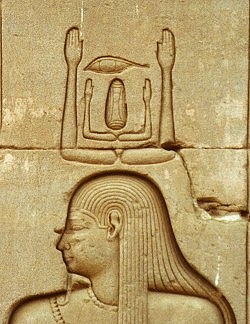
The untranslatable word ka was used by the ancient Egyptians to refer to that aspect of men and gods that is connected with the creative life force. The ka is the aspect that differentiates a living person from a dead one. The ka came into existence at the moment of birth, and was a kind of doppelgonger of the individual. Sometimes the ka was even depicted as a slightly smaller figure alongside the living person. The god Khnum is occasionally depicted seated at a potter's wheel making both the physical body of the person and his ka.
After someone died, the ka continued to exist (and thus also the person, because the body was only the visible expression of ka-power) and continued to need to be fed. This is why the ka was supplied with food through food offerings, offered to the false door in the tomb or through depictions of food on the walls of the tomb. The ka was expected to partake of the life-giving force contained in them. In recognition of this life-giving force, the Egyptians used to say 'to your ka' at mealtimes.
Tomb statues were considered to be statues of the ka of the deceased person, and sometimes they bore a ka symbol, as is the case with the statue of Hor. The ka was represented as a pair of open arms, held upwards. These arms symbolized the transmittance of the ka force from father to son, god to man, king to man. This transmittance was also expressed in personal names which emphasized the continuity of the ka in different generations, for example 'my ka repeats itself'. When a ka was transmitted from god to god or from god to man, it was the 'indwelling' of a divine force in a different god or person that was meant. Sometimes several kas are referred to; the creator gods and the king could have multiple kas, but so too could ordinary people. The names given in the Late Period to the kas of Re indicate that the principle of multiple kas is not just a multiplication of power, but was regarded as a splitting up of the ka force into various aspects, such as splendour, fame, life span, power, food, seeing, hearing, knowing. These aspects were made independent and perceived as the imperishable principles of life itself, not linked to the life of an individual.